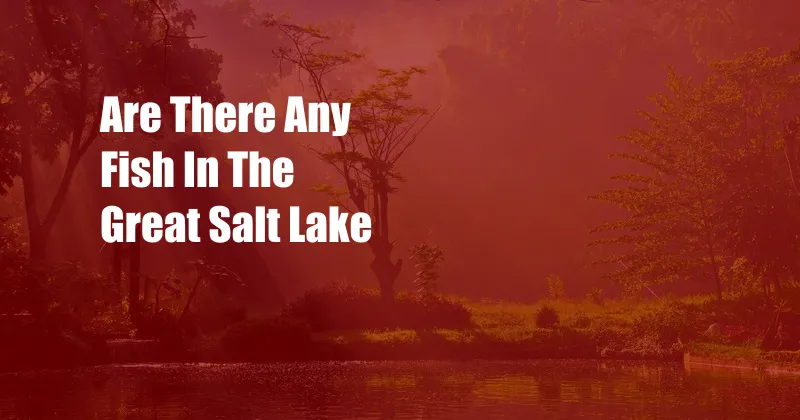
**The Great Salt Lake: A Unique Ecosystem with an Absence of Fish**
As I gazed across the vast, shimmering expanse of the Great Salt Lake, a question crossed my mind: could there possibly be any fish thriving in this hyper-saline environment? To my surprise, the answer is a resounding no. The Great Salt Lake, despite its immense size and ecological significance, is devoid of any known fish species.
This remarkable phenomenon begs the question: why is the Great Salt Lake unable to sustain fish life? To delve into this enigma, let’s explore the unique characteristics of this extraordinary water body.
**Understanding the Hypersaline Environment**
The Great Salt Lake is an endorheic basin, meaning it has no outlet to the ocean. As a result, water accumulates and evaporates over time, leaving behind a high concentration of dissolved salts. The lake’s salinity can reach up to 27%, more than eight times saltier than the ocean. This extreme salinity creates a harsh and inhospitable environment for most aquatic organisms.
The high salt content raises the osmotic pressure of the water, making it difficult for fish to maintain their internal water balance. Fish need to constantly drink water and excrete excess salt to survive in saltwater environments. However, in the Great Salt Lake, the osmotic pressure is so high that fish would have to expend an excessive amount of energy to maintain their equilibrium. This energy expenditure would outweigh any potential benefits of living in such an environment.
**Evolutionary Adaptations and Species Interactions**
Over millions of years, fish have evolved a variety of adaptations to cope with salinity, including specialized kidneys and gills. However, the extreme salinity of the Great Salt Lake has presented an insurmountable barrier to even the most adaptable fish species.
Furthermore, the lack of fish in the Great Salt Lake has cascading effects on the entire aquatic ecosystem. Since there are no fish to prey on zooplankton and other invertebrates, these organisms flourish in abundance. This abundance of zooplankton, in turn, attracts large populations of birds that feed on them, making the lake an important stopover point for migratory birds.
**The Resilience of the Great Salt Lake Ecosystem**
Despite the absence of fish, the Great Salt Lake is a thriving ecosystem, supporting a diverse array of organisms adapted to its unique conditions. Brine shrimp, brine flies, and alkali flies are among the most well-known inhabitants of the lake. These organisms have evolved unique salt-tolerant adaptations, allowing them to survive and even thrive in the harsh environment.
The Great Salt Lake is also home to several species of microscopic algae, which form the base of the lake’s food chain. These algae produce a red pigment that gives the lake its characteristic pink hue. The lake’s hypersaline conditions also support unique microbial communities, which play important roles in nutrient cycling and other ecological processes.
**Expert Insights and Conservation Efforts**
Ecologists and conservationists have devoted considerable effort to studying and protecting the unique ecosystem of the Great Salt Lake. Research has shown that the lake’s salinity fluctuates naturally over time, and that periods of lower salinity have allowed fish to temporarily inhabit the lake. However, as salinity levels rise, fish populations decline.
Efforts to protect the Great Salt Lake focus on maintaining the lake’s natural hydrology and salinity levels. This includes managing water diversions from the lake’s tributaries and protecting wetlands that help filter water entering the lake. By ensuring the long-term health of the Great Salt Lake, we can preserve this unique and irreplaceable ecosystem for future generations.
**FAQs about the Great Salt Lake and the Absence of Fish**
- Q: Why is the Great Salt Lake so salty?
A: The Great Salt Lake is salty because it is an endorheic basin, meaning it has no outlet to the ocean. Water accumulates and evaporates over time, leaving behind a high concentration of dissolved salts.
- Q: Can any fish species survive in the Great Salt Lake?
A: No, there are no known fish species that can survive in the Great Salt Lake’s extremely saline environment.
- Q: What organisms live in the Great Salt Lake?
A: The Great Salt Lake is home to a variety of organisms adapted to its high salinity, including brine shrimp, brine flies, alkali flies, microscopic algae, and microbial communities.
- Q: Why are there so many birds around the Great Salt Lake
A: The Great Salt Lake is an important stopover point for migratory birds because it attracts large populations of zooplankton and other invertebrates, which are a primary food source for many birds.
- Q: What is being done to protect the Great Salt Lake?
A: Conservation efforts focus on maintaining the lake’s natural hydrology and salinity levels, including managing water diversions and protecting wetlands that filter water entering the lake.
**Conclusion**
The Great Salt Lake is a remarkable and unique ecosystem, one that showcases the incredible diversity and resilience of life on Earth. While the lake may lack fish, it is home to a variety of organisms that have adapted to its unique conditions. By understanding the challenges and adaptations involved in living in such a hypersaline environment, we can better appreciate the fragility and importance of this extraordinary water body.
Are you interested in learning more about the Great Salt Lake and its unique inhabitants? Join us for a guided tour or explore the many online resources available to discover the wonders of this fascinating ecosystem.